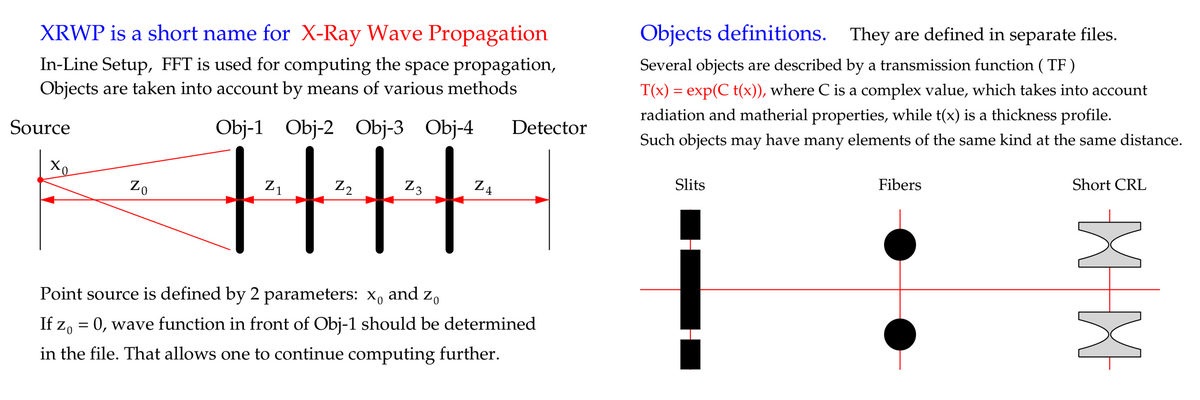
X-Ray Wave Propagation
universal X-ray optics program for SR and XFEL
This site presents a new version (06-05-2023) of the XRWP program. It calculates the intensity distribution in a beam of X-ray synchrotron radiation (SR), and more specifically, in its cross section, which is measured by a coordinate detector after the beam has passed through a series of objects located between the source and the detector at different distances inside the SR source station or at x-ray free electron laser (XFEL) stations. The program works both with two-dimensional objects, in which the electron density changes only along the x and z axes, and is uniform along the y axis, and with three-dimensional objects, the structure of which changes along the three axes x, y and z. Accordingly, it calculates either one-dimensional int(x) functions on a limited portion of the X-axis, or two-dimensional int(x,y) functions in a square region of a certain size on the XY plane. These functions describe the dimensionless relative radiation intensity. Usually the ratio of the intensity at the detector to the intensity in front of the first object is calculated, but there may be variations.
For two-dimensional objects, the program can also calculate two-dimensional distributions when the second argument is any other parameter of any object or the circuit as a whole. It is no longer reasonable to calculate three-dimensional and higher distributions, since the arrays turn out to be large and it is not convenient to view them. The versatility of the program is determined by the fact that objects can be very different and in any combination. And this is precisely what determines the complexity of working with the program, since different objects need different descriptions, different methods are used to calculate them, different methods for visualizing the results, and so on. On the other hand, this makes it possible to solve a variety of problems of modeling the results of in-line X-ray experiments using modern SR and XFEL sources. The author of the program is the author of this site. My personal website can be viewed by clicking the leftmost button with the name (Web site) in the top row of buttons. All the information is there.
The program partially presents the experience of my work in this field of science for more than 50 years, starting from graduate school in 1968 until 2023. For the last 30 years I have been programming in my own programming language called ACL (advanced command language). This is a scripting language. It is executed by an even more universal program written in Java. In fact, the user is dealing with a program written in Java. All information about the program is divided into sections, which are displayed in this window when you click on the corresponding button in the table of contents presented below. лике на соответствующую кнопку оглавления, представленного ниже.
The work is not finished yet. The program is developing and will continue to develop for a relatively long time. Accordingly, this site will be supplemented and changed. For this reason, I will set publication dates for materials. And don't forget to come here often. If you are interested in learning about changes by mail, please send me a request to my email address. The address is on my personal website.
![]() How to download and install the program. Technical issues and their solutions.
How to download and install the program. Technical issues and their solutions.
![]() Documentation for the program. How to use and Theoretical basis.
Documentation for the program. How to use and Theoretical basis.
![]() Introduction to the problem. About how and why it all began.
Introduction to the problem. About how and why it all began.
![]() Scientific articles that use the program.
Scientific articles that use the program.
.